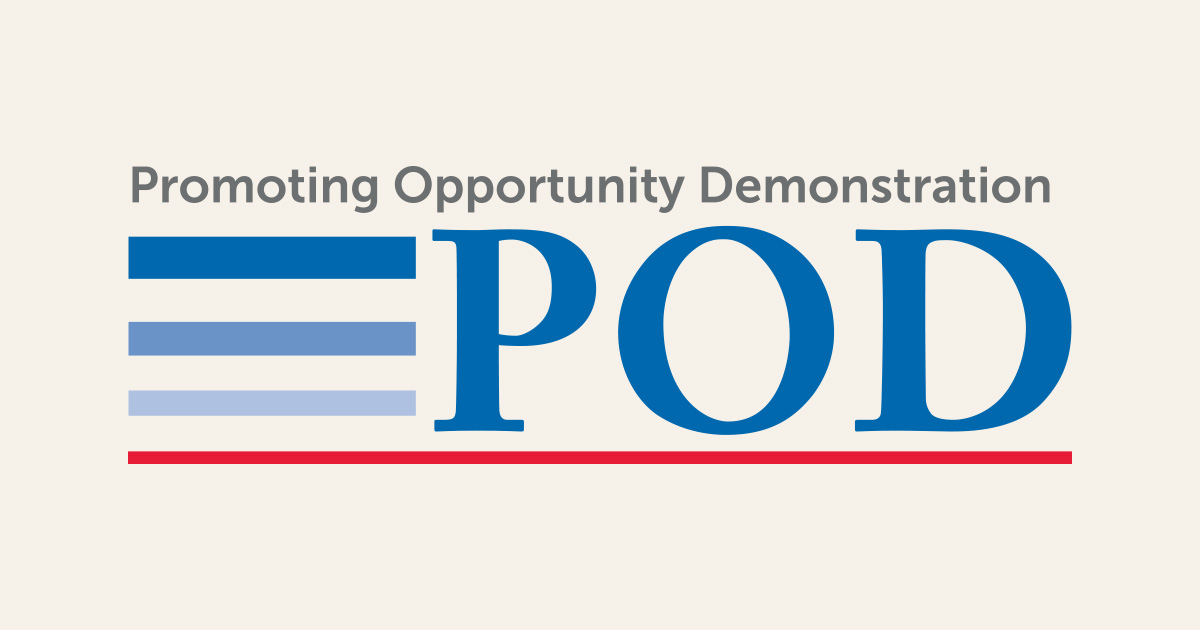Social Security Disability Insurance (SSDI) is the largest federal program that provides cash supports for qualifying people with disabilities. The Promoting Opportunity Demonstration (POD) tested modifications to SSDI program rules to determine if a benefit offset formula can promote employment, reduce people’s dependence on benefits, and decrease the program’s administrative complexity.
Under current rules, beneficiaries with earnings that exceed substantial gainful activity (SGA) limits can lose all of their benefits. In 2019, the monthly SGA amount for non-blind beneficiaries was $1,220. POD replaced this sudden loss of benefits—often called the “cash cliff”—with a $1 for $2 benefit offset for earnings above either the POD threshold or the beneficiary’s impairment-related work expenses, whichever amount was higher. POD also included modifications for other current rule provisions, such as removing the Trial Work Period.
“Before [POD], I was very concerned about losing my benefits, especially medical coverage, because I knew that my benefit check could potentially disappear…. It worried me that if I were to go out and find a job, and I wasn't able to hold it, I could potentially have lost my benefits. But [in] POD…, it just gave me more peace of mind to look for a job and accept that position.”
Experience shared by an SSDI beneficiary that volunteered for POD
Under current rules, beneficiaries with earnings that exceed substantial gainful activity (SGA) limits can lose all of their benefits. In 2019, the monthly SGA amount for non-blind beneficiaries was $1,220. POD replaced this sudden loss of benefits—often called the “cash cliff”—with a $1 for $2 benefit offset for earnings above either the POD threshold or the beneficiary’s impairment-related work expenses, whichever amount was higher. POD also included modifications for other current rule provisions, such as removing the Trial Work Period.
“Before [POD], I was very concerned about losing my benefits, especially medical coverage, because I knew that my benefit check could potentially disappear…. It worried me that if I were to go out and find a job, and I wasn't able to hold it, I could potentially have lost my benefits. But [in] POD…, it just gave me more peace of mind to look for a job and accept that position."
Experience shared by an SSDI beneficiary that volunteered for POD
POD was a randomized controlled trial that included two treatments of a benefit offset. The two treatment groups had the same benefit offset but different termination rules. Treatment group 1 (T1) did not face termination, but treatment group 2 (T2) faced termination after 12 consecutive months of earnings above the full offset amount (the point at which benefits were reduced to zero). Control group members continued to receive benefits under current rules.
SSA contracted with Abt Associates to lead the implementation of POD over a five-year period in eight sites, and with Mathematica to lead the evaluation with its partner Insight Policy Research. The eight sites included in the demonstration were:
- Alabama (all counties)
- California (Los Angeles, Orange, and San Diego counties)
- Connecticut (all counties)
- Maryland (Anne Arundel, Baltimore, Harford, Montgomery, and Prince George’s counties; Baltimore City)
- Michigan (Kent, Ionia, Clinton, Eaton, Shiawassee; Genesee and Lapeer counties)
- Nebraska (Adams, Buffalo, Douglas, Hall, Lancaster, and Sarpy counties)
- Texas (Bell, Bexar, Collin, Comal, Dallas, Denton, Ellis, Harris, Hays, Johnson, Kaufman, Montgomery, Parker, Tarrant, Travis, and Williamson counties)
- Vermont (all counties)
Findings from the evaluation of POD show that:
- Impacts on primary outcomes were limited. POD did not increase average earnings, SSDI benefits, or income. POD increased the percentage of beneficiaries who had substantive earnings above the annualized SGA amount by 1 percentage point.
- No substantive differences in benefit offset usage or impacts between the two treatment groups.
- Treatment group members faced substantive challenges reporting monthly earnings in a timely manner.
- Understanding of current and POD rules was limited. Treatment and control group members faced challenges with answering questions about how earnings affect benefits under POD and current rules.
Links to key POD evaluation publications are below.
POD evaluation design:
- Promoting Opportunity Demonstration: Design Report
POD evaluation reports:
POD special topic briefs:







